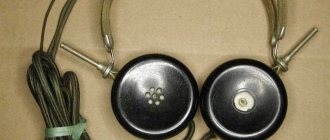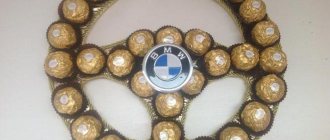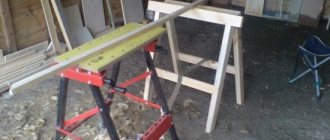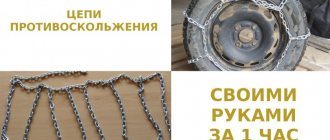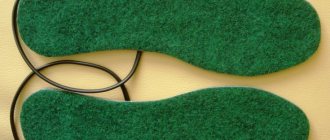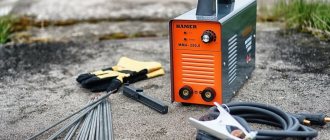Nowadays, few people can be surprised by fashionable headphones, but it’s a completely different matter if they are made by yourself. Such an accessory will become a distinctive feature and can also be an original gift. In addition, the problem of how to make an earphone arises when one of these paired accessories breaks. In order not to buy new ones, you can simply dismantle the old ones and make new ones from the remaining working speakers.
How to make headphones with your own hands
Let's start with step-by-step actions:
First you need to purchase an output that will be suitable for a computer or mobile source. The most common today is miniJack. Its diameter comes in 6.3 mm and 3.5 mm. The second one is more in demand and everyone has used it at least once in their life.
Now you need to remove the cover from the plug that you purchased. A strong and reliable cable must be passed through this hole so that it can have four cores.
The wire is secured with a stand on the top of the plug. It is equipped with a hole. For this hole it is necessary to solder several conductors. There are two conductors left. They need to be soldered to small contacts.
Secure the entire structure with electrical tape. Check the device with an ohmmeter for short circuit problems.
We are looking for several speakers that have the same diameter. Eight ohms should be the resistance of each of them. They need to be inserted into special bets. Typically, this procedure requires plastic jars.
You need to attach a metal ruler to the headband. Then we connect two wires to each of the emitters and connect one of them to the plug stand, the other to some small contact.
Not just a magnetoplanar
A few words about dynamic models. The design of the factory speakers themselves does not imply the possibility of any modification at all. Self-production of speakers of this size is very limited. As a result, almost all dynamic headphones remain with factory, mostly Chinese, drivers. At home, it is much easier to make a magnetoplanar driver. As a result, all attempts to independently develop dynamic headphones come down to installing Chinese speakers in a homemade housing. Even brands that claim to be elitist are guilty of this.
The problem with dynamic drivers is the existence of the so-called. exit points from the piston operating mode at a certain sound frequency. While in piston mode each point of the diffuser moves simultaneously with its neighbors in the same direction, beyond the transition frequency the sound wave begins to move along the diffuser like circles on water from a thrown stone. It is incredibly difficult to achieve high-quality transformation here - wave reflections throughout the moving system interfere. Ideally, the driver should not cross this point at all throughout the entire operating frequency band. But this is also difficult to achieve.
Speaker Focal Clear MG
Focal, for example, in its speakers has taken the path of maximizing the rigidity of the diffuser. They actively use magnesium alloy. Thus, the point of change of operating modes is shifted as far as possible into the high-frequency region. In this way, they ensure that the diffuser operates in piston mode over most of the spectrum, creating a minimum of distortion there. The complexity of manufacturing such a diffuser is extremely high and is currently difficult for use at home. It is worth noting that the use of monolithic diffusers made of various alloys or composites is rare, in contrast to the spraying of a small amount of metal onto a conventional polymer diffuser. This spraying has almost no benefit, since it practically does not add rigidity.
As a result, dynamic headphones do not have particularly great prospects for self-assembly in achieving the highest quality playback.
What about wireless headphones
Wireless headphones can be assembled. How to make wireless headphones? For this we need a couple of tools.
What is necessary
- The wire
- bluetooth adapter
- Charging device.
We carry out the assembly
- First you need to insert the Bluetooth adapter into the charger.
- We connect it to the stereo system.
- We open Bluetooth in the device through which music will be played.
- Let's connect and listen to music.
Now we have learned how to make Bluetooth headphones inexpensively and practically.
Throwing away the magnets
Electrostatic drivers stand apart in the world of DIY electroacoustics. They are based on the polarization of the membrane by a high electrical potential between two electrodes, where a voltage corresponding to the signal level is applied. Due to the attraction of unlike charges and the repulsion of like charges, the membrane moves. The whole problem is the need to apply a large (several hundred volts) polarizing voltage and the need to match the electrical load with the signal source.
The technology is quite mature. It is also used in large stereo systems, the cost of which is almost always exorbitant. In this industry, veterans like Stax are worth celebrating. Basically, evolution since then has been due to improvements in the electrical part: in the creation of more advanced amplifiers or matching circuits. Sometimes even with a hint of portability.
Historically, headphones using this technology have not gained much popularity precisely because of the complex and expensive electrical part and lack of portability. However, this technology is definitely of interest to local craftsmen due to its manufacturability. The complexity of the electrics also scares few people - in any case, it is customary to assemble them yourself so that the sound is truly “your own.”
Layer diagram of the electrostatic driver: 1 - PET film 2 - conductive layer, 3 - insulation layer
The topic of developing such headphones partially overlaps with the development of planars. The work here is done by a membrane, often made from the same PET film. It is necessary to create a continuous layer of current conductor on it. There are many ways to do this. The easiest one is to use antistatic spray. Ready-made metalized films are not suitable - most likely the layer on them will not withstand long-term use and will degrade.
Corrugation, unlike magnetic planars, is not used here. The average gap used between the membrane and the stator is only 0.5 mm. This value is a balance between sensitivity and range of the membrane. More - sensitivity begins to drop significantly. Less - the membrane in operation catches the stators.
On the left in the photo are stator grids, on the right are insulating rings
Based on such a small gap, it is worth taking care of the dielectric coating of the membrane so that upon contact with the stator, which is sure to happen, electrical breakdown does not occur, and as a result, damage to the membrane, not to mention damage to the amplifier or polarization source. There are plenty of coverage options. The easiest way to use PCB insulating varnish is in spray form. It is important that the layer is flexible and adheres well enough. The number of layers of both conductor and insulator on the film must be selected based on practical experience. The insulator layer can be applied twice or three times, you need to ensure uniformity of all layers.
The entire structure can be assembled on a frame made of conventional single-layer foil fiberglass. It is appropriate to use a CNC router here. It also wouldn’t hurt to insulate the stator grid with varnish.
Speaking about the electrical part, I will give the simplest example of a circuit with load matching and a constant high voltage source. The latter can be easily found assembled on Ali. The idea is to increase the signal voltage level from a conventional amplifier to the desired level, and polarize it using a step-up DC-DC converter.
The driver itself must be protected from external influences and sealed as much as possible. This can be done, for example, with the same film. Place it in a kind of airtight cocoon so that nothing can get inside.
Types of cable insulation. Particularly noteworthy are b - cordel, d - balloon and f - washer
It’s worth mentioning about the connection. Since high voltage is used, the insulator must be adequate. Moreover, you need to achieve a minimum electrical capacitance between the cores. This is necessary to avoid signal loss in the cable. Even a capacitance of 40 pF is already too large. You need at least 20 pF, and preferably several times less. This can be achieved by placing the wire in additional air insulation, for example, cord or washer insulation.
Microphone from headphones
If you are wondering how to make a microphone from headphones, then the answer is quite simple.
Many headphones (the speakers that produce sound) already have factory microphones installed. They allow you to communicate even on a computer without using a real microphone.
To do this, just insert the headphones into the computer, and then switch to the microphone.
Digging deeper
WM-61A electret capsules, which can be found even in calibrated measurement microphones
It is important to mention a special subtype of electrostatic drivers - electret drivers. This is a subtype of electrostatic converters, where polarization occurs not by applying high voltage through wires, but by accumulating a large static charge on the membrane material, the so-called. electret. If the electric field created by this charge is sufficient, then the system can operate with an electrical signal with a relatively small voltage amplitude. This technology is actively used in the ubiquitous electret microphones.
The problem is that it has not yet been possible to create a broadband electret driver that can be used in headphones. Models with this technology were produced only in the form of hybrids with other low-frequency units, mainly dynamic ones. More and more similar hybrid headphones are appearing, for example, the very affordable Chinese KZ ZEX. According to subjective sensations, the electret link in them leaves no chance for the fittings in terms of frequency response and distortion. I compared with Ikko OH-1, which are now gathering dust on the shelf. If we can get an electret driver large enough to reproduce frequencies from 20 hertz, it will be a big breakthrough.
The problem with electrets is mainly the difficulty of working with electret film - the material must be flexible and at the same time have uniform polarization, which is very difficult to achieve. In addition, the material itself is capricious and can lose its charge if the technology is violated. The electret also loses polarization over time. Although this time is comparable to the service time.
We can only hope for the emergence of technologies that will make it possible to make a broadband electret driver for headphones. This will be another round of development of electroacoustic equipment.
It's better to buy headphones or make it yourself
It depends on how well you handle technology. If it’s easier for you to make your own headphones, then it’s better to buy the necessary components.
But you can buy inexpensive headphones that are of good quality, so you don’t need to waste effort. However, if you decide to make them yourself, then patience is required.
Design and wearing comfort
The appearance of Bullets became a little less similar to cartridges compared to the first version, but still retained recognizable features. A round metal case with a characteristic annular groove near the slightly dented bottom, on which the company logo is applied. There is also a hole for acoustic ventilation. Closer to the sound guides there are colored rings marking the left (blue) and right (red) channels. The level of assembly is excellent, everything fits very neatly, and the metal immediately inspires confidence.
The cable is similar to the one used in Consonance v2, quite thick in cross-section, in silicone insulation and also reinforced with Kevlar. It doesn't get tangled or harden in the cold, but the microphone effect (the rustling sound of the cable rubbing against clothing) is quite noticeable. This is primarily due to the fact that the headphones are quite light and fit very deeply into the ear. The behind-the-ear fit and included clip allow you to virtually eliminate this problem.
The splitter block and plug are made of plastic; the cable exit point from the headphones is also protected by plastic inserts. Of course, it would be great if they were metal, it would look in the same style as the headphones themselves, but, apparently, this would not allow achieving the desired cost.
The included tips are pleasantly soft, you can wear the headphones with them for an unlimited time, the small weight and size of the headphones also contribute to comfort, they are well suited for people with small ears. Sound insulation is at an average level; headphones are not suitable for very noisy environments.
Headphones with microphone
So, to find out how to make headphones with a microphone, just re-read the article again. Headphones with microphone required. You can make headphones using the method that we described step by step above.
However, if you need headphones with a microphone, then you need to find headphones that have a microphone. Then it will be possible to carry out the task you want to complete.
Remember that in this business you need to be good at soldering and working with micro parts.
Porridge from an ax
When nothing remains of the original headphones except the membrane, the question arises: what kind of headphones are these? I also want to optimize the topology of the tracks in my own way, choose magnets of a complex streamlined shape so that they have less influence on the passage of sound and provide a more uniform magnetic field. Make the entire system larger to increase the effective area, thereby increasing the output at low frequencies. You can also play with materials...
As a result, completely original headphones with a unique set of characteristics are born. Along the way, a large number of aspects arise that craftsmen have learned to work with one way or another. Let's dive into the details.
The basis is the body. Don't be shy about using a 3D printer. Due to the variety of materials and the ability to do partial filling, the acoustic and strength properties of printed enclosures may be most suitable. It is worth paying attention to composites with different fillings - fiberglass and carbon fiber. Such materials have increased rigidity, although printing with them is quite difficult.
Nobody canceled the strength of proof. It is worth carefully monitoring the strength of the entire system. The slightest deformation of the magnet body should not be allowed; this can lead to curvature of the magnetic field, not to mention complete destruction under the force of magnetic attraction. There should not be even a hint of deformation in the assembled state. The case must be able to withstand a free fall from table height.
Example of a membrane with variable track density
A one-sided magnet system is a bad choice; there should be magnets on both sides. It is necessary to strive for maximum linearity of the magnetic field throughout the entire working area, because any nonlinearity in the conversion of electric current into mechanical movement causes nonlinear distortions that must be avoided. If you make a uniform magnetic field, you can leave tracks with a constant pitch on the membrane. To calculate the magnetic field, there is also open source software, for example, femm.
An example of calculating the magnetic field for a ribbon driver in femm. Pay attention to the field density at the corners of the magnets
A nonlinear magnetic system is justified only when you make the membrane as open as possible with a large stroke in the working area, but in this case you need to compensate for the nonlinearity of the field with a variable density of tracks.
Openness to sound waves of a magnetic system is also very important; it is advisable to look for magnets with a profile other than a rectangle if they are in the path of the wave, so that diffraction does not occur at the corners, which introduces a large amount of distortion. In addition, a high magnetic field density accumulates at the corners and it is more difficult to achieve high linearity with them.
There are no objective reasons to make complex shapes of magnets and tracks. A magnet in the form of an arc does not provide any advantages over a straight one. But it adds a huge amount of headaches with calculating the shape of the tracks and creating the body. It is only justified to use magnets of different lengths in order to use the maximum area of the cups if their shape is round.
A clear example of membrane corrugation - wave
In my opinion, membrane corrugation is underestimated. Drivers typically use PET film of varying thicknesses. But this film itself stretches within small limits. Where do low frequencies come from in such a system? Only due to its molding. An accordion, or something more complicated, is not so important. You need to pack as much membrane as possible into as little volume as possible. There are a huge number of ways.
Along the vertical axis is the applied force, along the horizontal axis is the relative elongation of the material. Point 2 on this graph is the end of the proportionality zone, after which the elongation is no longer linear with respect to the applied force. Then the region of plastic deformation begins
Debugging the corrugation process can be called the most important step in the later stages of development, when the magnetic system and track topology have already been optimized. What is especially depressing is that in a noticeable number of serial headphones, corrugation is absent as a phenomenon - the membrane is stretched like a string. Without corrugation, it works as a rather hard signal compressor with a very short attack time (the time the membrane moves from the rest position to the point of proportionality limit), smoothing out all the edges of the signal, which completely kills the fidelity of playback. Corrugation allows you to radically expand the limits of proportionality on both sides of the rest position, essentially replacing tension-type deformation with bending-type deformation for most of the working stroke of the membrane, which for a thin membrane is linear over a large interval.
It may be advisable not to secure the membrane around the entire perimeter if the shape of the work area is a rectangle. By securing the membrane on only two opposite sides, you will give the membrane much greater freedom. For this you will get low-end feedback and a powerful attack.
Don't chase ultra-thin materials and exotics. A PET membrane film thickness of 8-10 microns is sufficient; the same thickness can be chosen for foil (copper or aluminum, whichever is more convenient for you). In addition to durability, get availability and a low price. There are orders of magnitude more important points that are worth paying attention to - this is the topology of the tracks and the magnetic field, as well as the acoustic characteristics of the sound channel. Well, corrugation. The same gold tracks will not provide advantages, giving only a cosmic price and a huge headache with manufacturing technology. In this case, corrugation may become completely impossible.
A promising direction is magnetron sputtering of a conductor directly onto the membrane. This will get rid of the adhesive layer and create a stronger connection between the metal and the film. For now, this is an experimental area and there has not been much success in the DIY environment.
Open source software option for acoustics calculations. Unfortunately, the sources and links are lost
Acoustics of the sound channel. I would boil it all down to one principle: the fewer barriers, the better. And if obstacles cannot be avoided, then you need to make sure that they are not too dangerous. I advise you to at least use this applet, which allows you to evaluate the nature of the propagation of sound waves in a medium. It’s better to use specialized software for calculating acoustics. This is especially necessary if for some reason it is necessary to use several emitters. In general, acoustic design is equally important for all types of radiators.
T50RP body damped with stone wool, not to be confused with glass wool
It also makes sense to use a damper similar to what is used inside speaker cabinets. So, if the membrane has a large free play, it must be damped with acoustic resistance. Otherwise, when removed from the head, at low frequencies the membrane will reach its extreme positions, which is not very good from the point of view of reliability. For information about the acoustic properties of materials, you can look at the thread about modifications of Fostex T50RP, where the frequency response is presented after adding one or another damper. This is true for both closed and open versions. In the first case, the damper will reduce reflections from the walls of the cup; in the second, it will match the load on the membrane, suppressing certain frequencies, primarily the lows, if they are unnecessary. In general, for an open design, if the sound channel is properly designed, a damper is not necessary.
Photo tips on how to make headphones
Sound
The following equipment was used for listening:
- Yulong DA8 as a DAC
- Yulong A28 as an amplifier
- Apple MacBook Pro Retina 2013 as a source
- Fidelia as a player
- Shanling M3 and Fiio X5 as portable players
- VSonic Gr01 and HiFiMan Re600 as headphones for comparison
- High-resolution recordings in Lossless formats (Dr. Chesky The Ultimate Headphone Demonstration Disc and others)
Before listening, the headphones were warmed up for 48 hours.
The new “bullets” can hardly be called a continuation of the previous model, they sound differently, they have more flavor and in their case there is no need to talk about monitoriness and evenness.
The bass is very good for its price, it is collected, detailed, its texture is very good, the headphones lack the deepest sub-bass a little, but overall the low-frequency range is very pleasing.
The mids are quite smooth, with good detail, although they lack speed a little, so the headphones are not suitable for brutal genres. Vocals, oddly enough, are quite successful in Bullets, with the vocalist most often being pushed forward on the imaginary sound stage. Many compositions really benefit from this.
High frequencies are a little uneven. They are at the same time slightly weakened, but sibilance appears on some tracks. Actually, given the price of the headphones, this cannot be called a serious drawback, but it cements their status as a taste decision.
The sound of the headphones is clearly not universal. For some bands and genres it's great, it just doesn't seem like it could be better, but for others the Bullets 6mm isn't the best choice. They are absolutely not suitable for brutal types of metal. On the other hand, the headphones are recommended for connoisseurs of electronic music, vocal compositions, and not hard rock, where their bass and voice delivery will come in handy. In other cases, their perception depends on the personal preferences of the listener. In general, the typical situation is “either you’ll hate it or you’ll love it,” there’s actually no other option.
